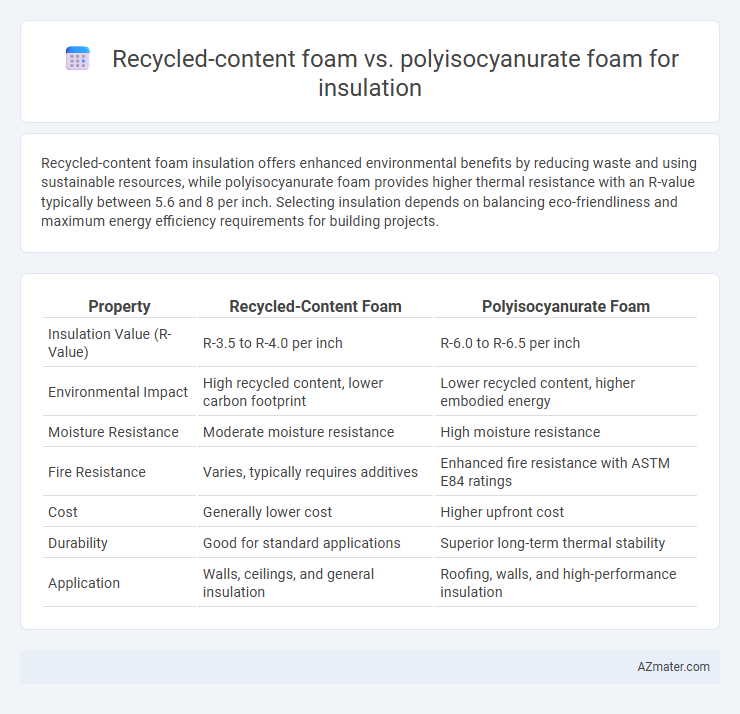Recycled-content foam insulation offers enhanced environmental benefits by reducing waste and using sustainable resources, while polyisocyanurate foam provides higher thermal resistance with an R-value typically between 5.6 and 8 per inch. Selecting insulation depends on balancing eco-friendliness and maximum energy efficiency requirements for building projects.
Table of Comparison
| Property | Recycled-Content Foam | Polyisocyanurate Foam |
|---|---|---|
| Insulation Value (R-Value) | R-3.5 to R-4.0 per inch | R-6.0 to R-6.5 per inch |
| Environmental Impact | High recycled content, lower carbon footprint | Lower recycled content, higher embodied energy |
| Moisture Resistance | Moderate moisture resistance | High moisture resistance |
| Fire Resistance | Varies, typically requires additives | Enhanced fire resistance with ASTM E84 ratings |
| Cost | Generally lower cost | Higher upfront cost |
| Durability | Good for standard applications | Superior long-term thermal stability |
| Application | Walls, ceilings, and general insulation | Roofing, walls, and high-performance insulation |
Introduction to Insulation Foam Options
Recycled-content foam insulation offers an eco-friendly alternative by incorporating post-consumer and industrial waste materials, reducing environmental impact while providing effective thermal resistance. Polyisocyanurate foam, known for its high R-value per inch and excellent thermal performance, is widely used in commercial and residential insulation applications to improve energy efficiency. Both options present unique benefits in terms of sustainability and insulation effectiveness, catering to diverse building requirements.
Understanding Recycled-Content Foam
Recycled-content foam insulation incorporates post-consumer or industrial waste materials, reducing environmental impact while maintaining thermal performance comparable to traditional options. This foam offers benefits such as lower embodied carbon and enhanced sustainability without compromising R-value, which typically ranges between 3.5 to 4.5 per inch. Understanding its compatibility with various building assemblies and installation methods is crucial for optimizing energy efficiency and meeting green building standards.
What is Polyisocyanurate Foam?
Polyisocyanurate foam, commonly known as polyiso, is a rigid, closed-cell foam insulation material known for its high thermal resistance and fire-retardant properties. It consists of a polymer formed by the reaction of polyols and isocyanates, typically enhanced with a foaming agent to create a lightweight yet durable board. Compared to recycled-content foam options, polyisocyanurate foam offers superior R-values per inch, making it a preferred choice for energy-efficient building insulation.
Thermal Performance Comparison
Recycled-content foam insulation typically offers thermal performance with R-values ranging from 3.5 to 4.0 per inch, whereas polyisocyanurate foam delivers higher thermal resistance, often exceeding R-6 per inch. Polyisocyanurate foam's closed-cell structure enhances its ability to reduce heat transfer, making it more efficient for thermal insulation in various climates. While recycled-content foam contributes to sustainability, polyisocyanurate foam provides superior insulation effectiveness, contributing to energy savings and reduced heating and cooling demands.
Environmental Impact and Sustainability
Recycled-content foam insulation reduces landfill waste and lowers carbon emissions by reusing post-consumer materials, contributing significantly to resource conservation. Polyisocyanurate foam offers high thermal efficiency but relies on petrochemical feedstocks, leading to higher embodied energy and potential environmental concerns in production and disposal. Choosing recycled-content foam supports circular economy principles, while polyisocyanurate requires careful management to mitigate its environmental footprint.
Cost Analysis: Recycled vs Polyisocyanurate
Recycled-content foam insulation generally offers a lower upfront cost compared to polyisocyanurate foam, making it attractive for budget-conscious projects. Polyisocyanurate foam provides superior thermal resistance with higher R-values per inch, potentially reducing long-term energy expenses despite its higher initial price. Cost analysis must factor in installation complexity, lifespan, and regional energy rates to determine overall value between recycled-content and polyisocyanurate foam insulation options.
Moisture Resistance and Durability
Recycled-content foam insulation offers moderate moisture resistance suitable for many residential applications but can deteriorate when exposed to prolonged water exposure, compromising durability. Polyisocyanurate foam provides superior moisture resistance with closed-cell structure, significantly reducing water absorption and ensuring long-term dimensional stability and performance. Its enhanced durability makes polyisocyanurate foam ideal for environments prone to humidity or water infiltration, outperforming recycled-content foam in maintaining insulation integrity.
Installation Methods and Ease
Recycled-content foam insulation typically requires careful handling and specialized application techniques such as spray or foam-in-place methods to ensure optimal adhesion and performance. Polyisocyanurate (polyiso) foam boards offer straightforward installation, often involving cutting to size and mechanical fastening or adhesive bonding, making them ideal for rapid deployment in both new and retrofit projects. The ease of installation with polyiso foam results in less labor time and reduced risk of application errors compared to the meticulous process required for recycled-content spray foams.
Indoor Air Quality Considerations
Recycled-content foam insulation often contains fewer volatile organic compounds (VOCs), contributing to improved indoor air quality compared to polyisocyanurate foam, which may emit higher levels of off-gassing chemicals during and after installation. Polyisocyanurate foam's rigid structure provides excellent thermal resistance, but its chemical composition can release formaldehyde and other irritants that affect respiratory health. Selecting recycled-content foam supports sustainable building practices while minimizing potential indoor pollutants, making it a preferable choice for environments prioritizing air quality and occupant well-being.
Choosing the Best Foam for Your Project
Selecting the best foam insulation involves comparing recycled-content foam and polyisocyanurate foam based on thermal performance, environmental impact, and cost efficiency. Polyisocyanurate foam offers higher R-values per inch, enhancing energy efficiency in tight spaces, while recycled-content foam prioritizes sustainability with reduced carbon footprint and recycled material content. Project requirements such as climate, budget, and environmental goals determine the optimal choice between these materials for superior insulation results.

Infographic: Recycled-content foam vs Polyisocyanurate foam for Insulation
 azmater.com
azmater.com